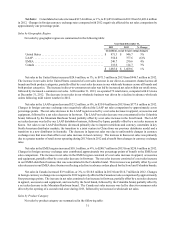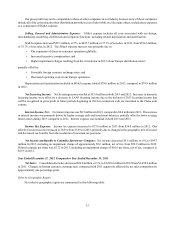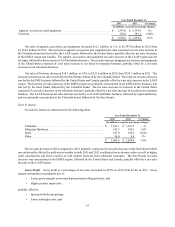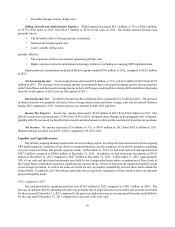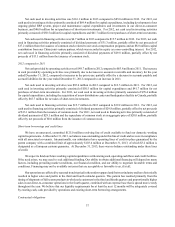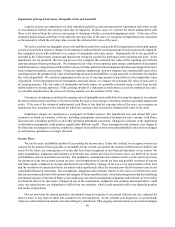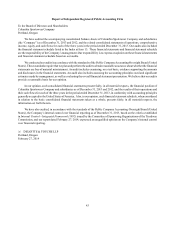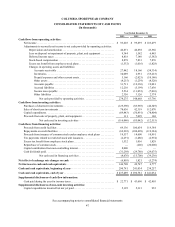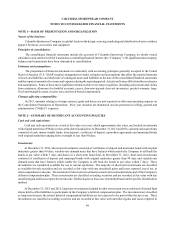Columbia Sportswear 2013 Annual Report Download - page 44
Download and view the complete annual report
Please find page 44 of the 2013 Columbia Sportswear annual report below. You can navigate through the pages in the report by either clicking on the pages listed below, or by using the keyword search tool below to find specific information within the annual report.40
Impairment of Long-Lived Assets, Intangible Assets and Goodwill
Long-lived assets are amortized over their estimated useful lives and are measured for impairment only when events
or circumstances indicate the carrying value may be impaired. In these cases, we estimate the future undiscounted cash
flows to be derived from the asset or asset group to determine whether a potential impairment exists. If the sum of the
estimated undiscounted cash flows is less than the carrying value of the asset, we recognize an impairment loss, measured
as the amount by which the carrying value exceeds the estimated fair value of the asset.
We review and test our intangible assets with indefinite useful lives and goodwill for impairment in the fourth quarter
of each year and when events or changes in circumstances indicate that the carrying amount of such assets may be impaired.
Our intangible assets with indefinite lives consist of trademarks and trade names. Substantially all of our goodwill is
recorded in the United States segment and impairment testing for goodwill is performed at the reporting unit level. In the
impairment test for goodwill, the two-step process first compares the estimated fair value of the reporting unit with the
carrying amount of that reporting unit. We estimate the fair value of our reporting units using a combination of discounted
cash flow analysis, comparisons with the market values of similar publicly traded companies and other operating performance
based valuation methods, as necessary. If step one indicates impairment, step two compares the estimated fair value of the
reporting unit to the estimated fair value of all reporting unit assets and liabilities, except goodwill, to determine the implied
fair value of goodwill. We calculate impairment as the excess of carrying amount of goodwill over the implied fair value
of goodwill. In the impairment tests for trademarks and trade names, we compare the estimated fair value of each asset to
its carrying amount. The fair values of trademarks and trade names are generally estimated using a relief from royalty
method under the income approach. If the carrying amount of a trademark or trade name exceeds its estimated fair value,
we calculate impairment as the excess of carrying amount over the estimate of fair value.
If events or circumstances indicate the carrying value of intangible assets with finite lives may be impaired, we estimate
the future undiscounted cash flows to be derived from the asset or asset group to determine whether a potential impairment
exists. If the sum of the estimated undiscounted cash flows is less than the carrying value of the asset, we recognize an
impairment loss, measured as the amount by which the carrying value exceeds the estimated fair value of the asset.
Impairment charges are classified as a component of SG&A expense. The impairment tests and related fair value
estimates are based on a number of factors, including assumptions and estimates for projected sales, income, cash flows,
discount rates, remaining useful lives and other operating performance measures. Changes in estimates or the application
of alternative assumptions could produce significantly different results. These assumptions and estimates may change in
the future due to changes in economic conditions, changes in our ability to meet sales and profitability objectives or changes
in our business operations or strategic direction.
Income Taxes
We use the asset and liability method of accounting for income taxes. Under this method, we recognize income tax
expense for the amount of taxes payable or refundable for the current year and for the amount of deferred tax liabilities and
assets for the future tax consequences of events that have been recognized in our financial statements or tax returns. We
make assumptions, judgments and estimates to determine our current provision for income taxes, our deferred tax assets
and liabilities, and our uncertain tax positions. Our judgments, assumptions and estimates relative to the current provision
for income tax take into account current tax laws, our interpretation of current tax laws and possible outcomes of current
and future audits conducted by foreign and domestic tax authorities. Changes in tax law or our interpretation of tax laws
and the resolution of current and future tax audits could significantly affect the amounts provided for income taxes in our
consolidated financial statements. Our assumptions, judgments and estimates relative to the value of a deferred tax asset
take into account predictions of the amount and category of future taxable income. Actual operating results and the underlying
amount and category of income in future years could cause our current assumptions, judgments and estimates of recoverable
net deferred taxes to be inaccurate. Changes in any of the assumptions, judgments and estimates mentioned above could
cause our actual income tax obligations to differ from our estimates, which could materially affect our financial position
and results of operations.
Our tax provision for interim periods is determined using an estimate of our annual effective tax rate, adjusted for
discrete items, if any, that are taken into account in the relevant period. As the calendar year progresses, we periodically
refine our estimate based on actual events and earnings by jurisdiction. This ongoing estimation process can result in changes



